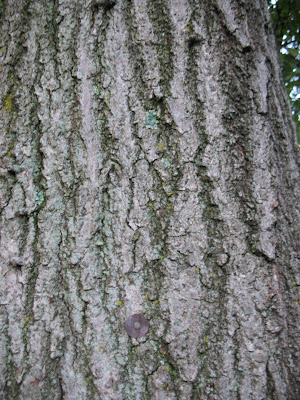It's not a matter of black and white! The two young oaks pictured above are a white oak and a black oak growing in the woods in Edgartown Massachusetts. To label them black and white seems like quite an exaggeration, but the trees are so called because of their bark color. (The lightest flecks on both trees are lichens, not bark.)
The complex oak genus has hundreds of species. Many of the species complicate life for classifiers by cross-breeding with each other. Botanists divide the oaks into two groups: the white oak group and the red/black oak group.
The majestic northern red oak, one of the two headliners of the red/black oak group, is New Jersey's state tree. Plainfield is blessed to have many beautiful examples. Red oaks are the fastest growing of the native oaks. We shouldn't be surprised that red oaks are some of the largest trees in Plainfield.
There is a very fine red oak at 916 West Eighth Street, pictured above. How to recognize it as a red oak, Quercus rubra? First, you can put it in the red/black oak group by observing that the lobes of the leaves end in points, (bristle tips). The leaf lobes of the white oak group, by contrast, are rounded. The photograph below shows a red oak leaf on the left and a white oak leaf on the right. The bark color also helps in assigning a group.(1)
That's a start, but how do we know that it's a red oak, and not another member of the red/black group? How do we distinguish it from a pin, scarlet, or black oak? Like red oaks, all those other three species have lobed leaves with bristle tips, and all can be found in the Plainfield area. Red oak leaves are easily distinguished from pin (Quercus palustris) or scarlet (Quercus coccinea) oak leaves because the red oak leaves are much larger. Their lobes are also much less deeply cut. The large acorn and the leaf on the right in the photograph below are from a red oak. The leaf on the left is from a pin oak.
Black oaks (Quercus velutina) can be more difficult to distinguish from red oaks. Black oaks have large leaves, but the leaves are more leathery and lustrous than red oak leaves. Unfortunately, they interbreed quite readily with red oaks, so it's hard to know sometimes whether or not you're really looking at a black oak. (2) Other features of the trees can help with speciation. Red oaks have much larger acorns than black oaks. Red oak acorns have a distinctive look, with a very shallow, saucer-like cap. Mature red oak bark is described as resembling interweaving ski tracks.
Another very handsome, mature red oak is at Stelle Avenue near Central. This magnificent street tree was the subject of some concern two or three years ago when the owner of the adjacent Coriell mansion proposed to restore the semicircular driveway that had once opened onto Stelle Avenue. The driveway was to encircle the red oak. Because the house was being converted to a B & B, the fire department wanted the driveway to be wide enough to accommodate fire trucks. The Historic Preservation Commission intervened to have the driveway narrowed so as to limit damage to the tree's roots.
The handsome red oak at the corner of 1300 Prospect Avenue at the corner of Hillside has a vase-like shape reminiscent of that of an American elm.
The massive red oak at 947 Fernwood pictured below was given special recognition as a specimen tree by Mayor Robinson-Briggs at this past April's Arbor Day celebration.
Another very fine red oak is at 912 Central Avenue. I measured its circumference today at 17 feet at breast height.
(1) Bark color is not necessarily a reliable indicator. Chestnut oak (Quercus prinus or Quercus montana), a member of the white oak group, has bark that is quite dark gray, an exception to the general rule that trees of the white oak group have light-colored bark. The chestnut oak pictured below is on Park Avenue near Randolph Road, across the street from Muhlenberg Hospital. See the January 13, 2008 posting of Plainfield Trees for additional differences between oaks of the white and red/black groups.
(2) The Trees of Pennsylvania and the Northeast, Charles Fergus, Stackpole Books 2002, p. 113.
Copyright Gregory Palermo









